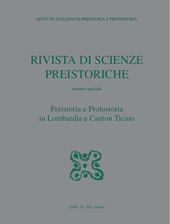Lavagnone (Desenzano del Garda-Lonato, BS) : aggiornamento sulle ricerche in corso dell'Università La Statale di Milano
P. 459-476
This paper aims to provide an update on the research carried out by the University of Milan over the last 10 years at Lavagnone (Desenzano del Garda – Lonato, Brescia). Lavagnone is one of the 111 “Prehistoric Pile Dwellings around the Alps” listed as UNESCO World Heritage. It takes its name from a small lake basin of c. 16 ha, located 3.4 km south of Desenzano del Garda. The site was settled throughout the whole Bronze Age. At the beginning of the Early Bronze Age the basin had already begun to dry up, turning into a marsh. In the very early 1900s it was still marshy, and so it remained until 1911, when reclamation works were made. Modern investigations began in 1971. The wet environment allowed for the preservation of the wooden structures of the pile dwellings, as well as of a wide range of organic remains, thus enabling dendrochronological, palaeoeconomical and palaeoenviromental analyses.
Therefore, Lavagnone is crucial for understanding the Early Bronze Age Polada Culture and the north Italian Bronze Age as a whole. Ongoing excavations in Sectors E and D focus on the most recent habitation phases. Hitherto, the developed Middle Bronze Age assemblages recovered from Sectors D and E were scarcely attested at Lavagnone (specifically, only in heavily eroded surface levels near the northwestern shore [Sector B] and from a test pit dug in proximity of the southeastern shore).
More generally, even in the whole Lake Garda region these phases are poorly attested through stratigraphic excavations. Hence, the research at Lavagnone can contribute to a more comprehensive knowledge of the peopling as well as of the cultural and chronological aspects of the phases following the well-known Early Bronze Age phases. Finds from Lavagnone allow to establish linkages with the Terramare sites in the Po Valley. Furthermore, some exceptional finds, probably linked to ritual activity at the site, are mentioned here, namely a monoxylous boat and a yoke from Sector D, and human remains (a skull and a mandible) from Sector E. [Publisher's text]
Forma parte de
Rivista di scienze preistoriche : LXXII, supplemento, 2022-
Artículos del mismo número (disponibles individualmente)
-
Información
Código DOI: 10.32097/1188
ISSN: 2282-457X


